Abstract
The purpose of the study was to map the functional neuroanatomy of simple associative learning in humans. Eyeblink conditioning was studied in eight normal volunteers using positron emission tomography and H215O. Regional cerebral blood flow was assessed during three sequential phases: (i) explicitly unpaired presentations of the unconditioned stimulus (air puff to the right eye) and conditioned stimulus (binaural tone), (ii) paired presentations of the two stimuli (associative learning), and (iii) presentation of the conditioned stimulus alone. During associative learning, relative to the unpaired phase, blood flow was significantly increased in primary auditory and left posterior cingulate cortices and significantly decreased in areas of the right cerebellar, right prefrontal, right parietal, and insular cortices and right neostriatum. The lateralization of the changes may relate to the functional organization of memory and learning processes in the brain. The activation in primary auditory cortex is an example, using a neuroimaging technique, of a learning-related change in primary sensory cortex in humans. The changes in areas such as the cerebellum, prefrontal cortex, and neostriatum provide support for their roles in associative learning as proposed by animal models. Moreover, these findings show that in humans, even simple classical conditioning involves distributed changes in multiple neural systems.
Full text
PDF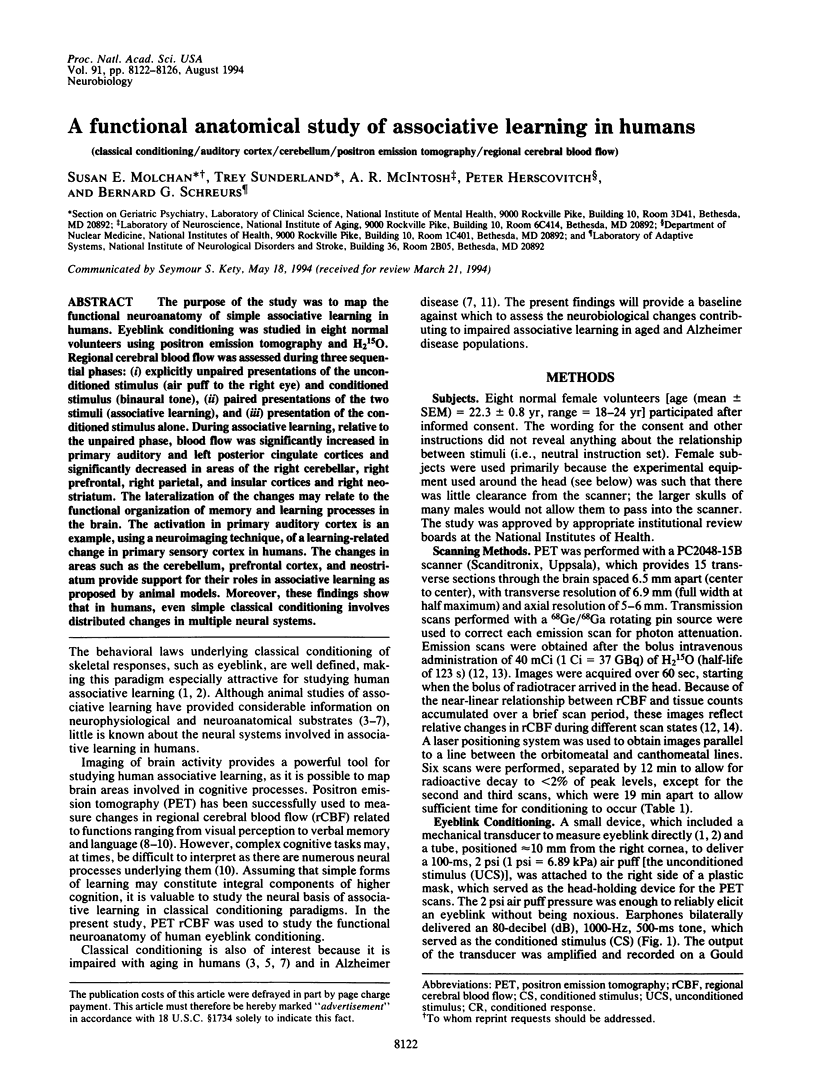
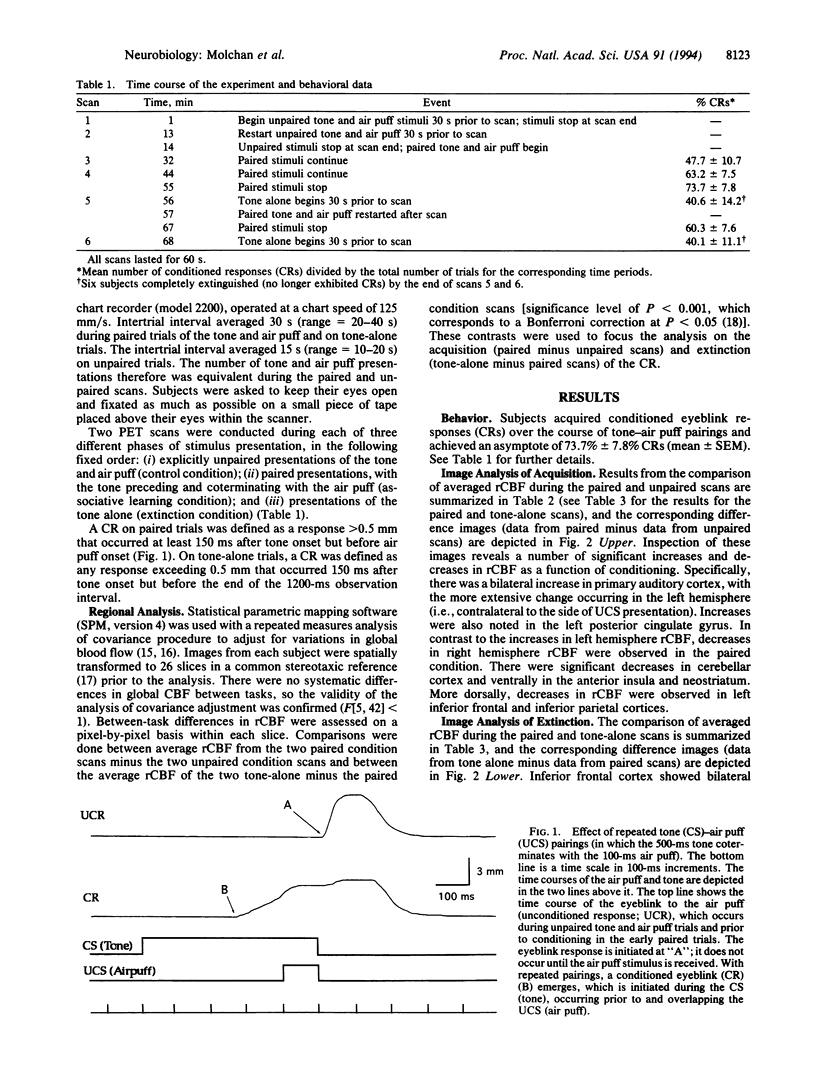
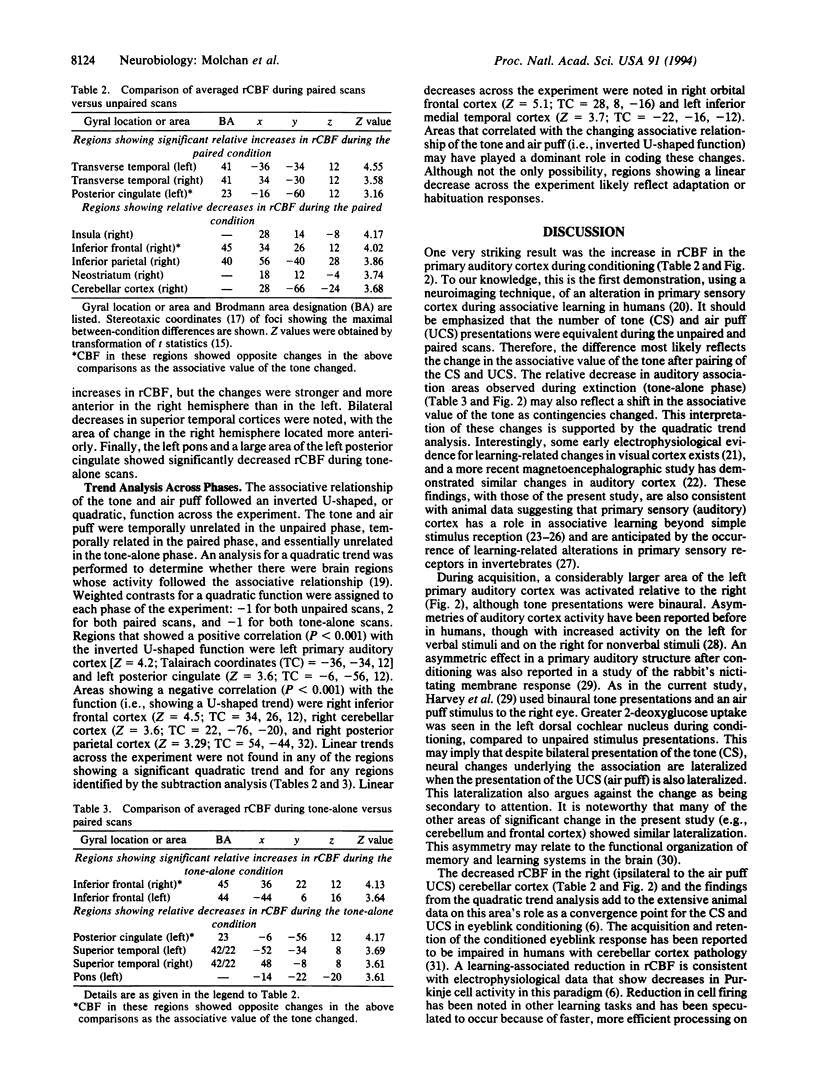
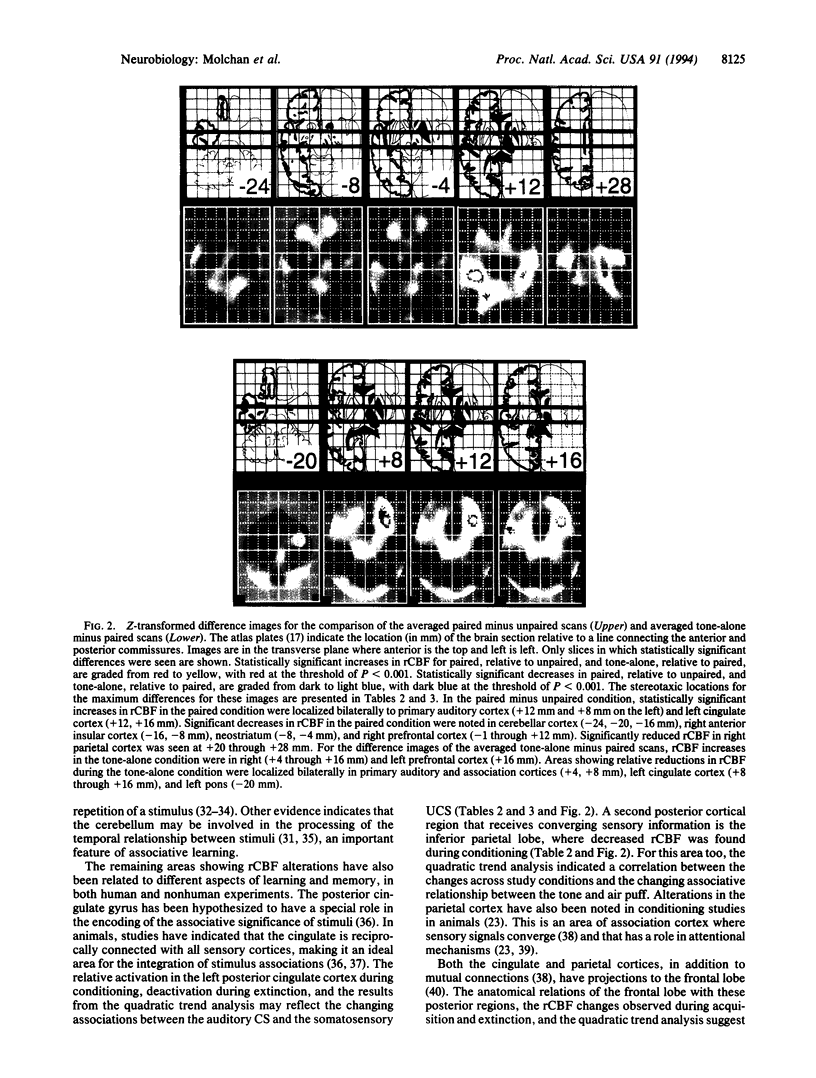
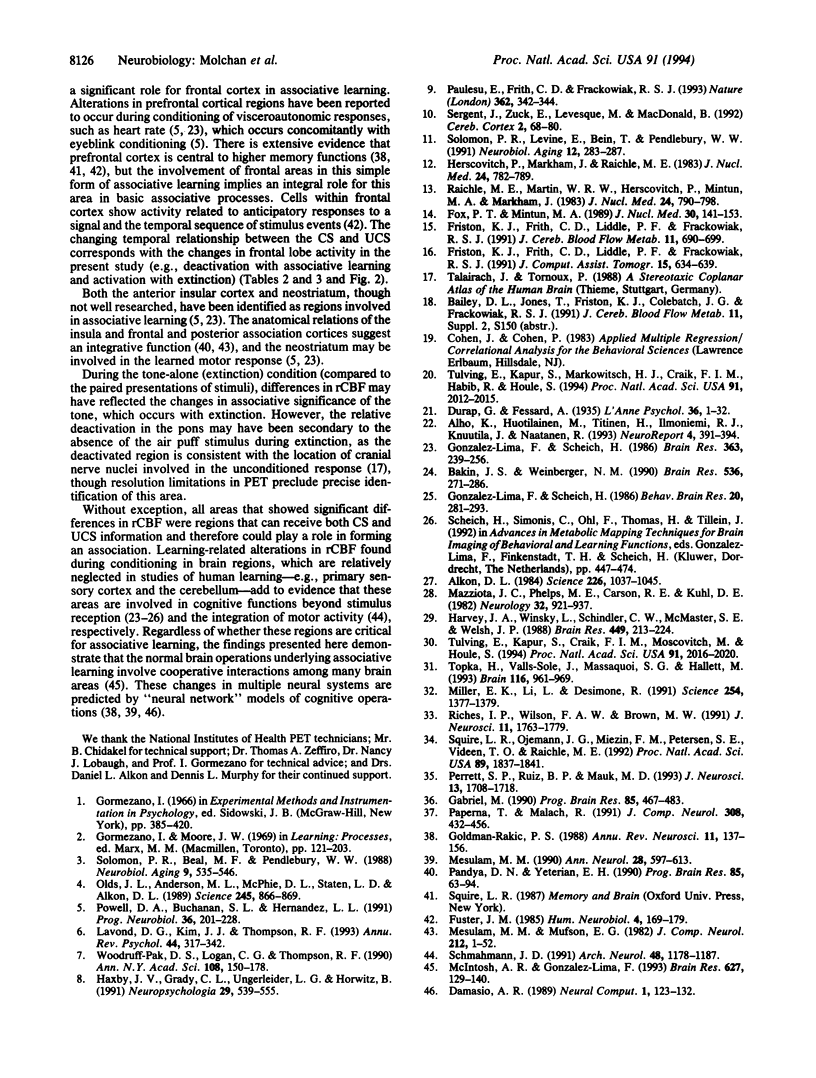
Images in this article
Selected References
These references are in PubMed. This may not be the complete list of references from this article.
- Alho K., Huotilainen M., Tiitinen H., Ilmoniemi R. J., Knuutila J., Nätänen R. Memory-related processing of complex sound patterns in human auditory cortex: a MEG study. Neuroreport. 1993 Apr;4(4):391–394. doi: 10.1097/00001756-199304000-00012. [DOI] [PubMed] [Google Scholar]
- Alkon D. L. Calcium-mediated reduction of ionic currents: a biophysical memory trace. Science. 1984 Nov 30;226(4678):1037–1045. doi: 10.1126/science.6093258. [DOI] [PubMed] [Google Scholar]
- Bakin J. S., Weinberger N. M. Classical conditioning induces CS-specific receptive field plasticity in the auditory cortex of the guinea pig. Brain Res. 1990 Dec 17;536(1-2):271–286. doi: 10.1016/0006-8993(90)90035-a. [DOI] [PubMed] [Google Scholar]
- Fox P. T., Mintun M. A. Noninvasive functional brain mapping by change-distribution analysis of averaged PET images of H215O tissue activity. J Nucl Med. 1989 Feb;30(2):141–149. [PubMed] [Google Scholar]
- Friston K. J., Frith C. D., Liddle P. F., Frackowiak R. S. Comparing functional (PET) images: the assessment of significant change. J Cereb Blood Flow Metab. 1991 Jul;11(4):690–699. doi: 10.1038/jcbfm.1991.122. [DOI] [PubMed] [Google Scholar]
- Friston K. J., Frith C. D., Liddle P. F., Frackowiak R. S. Plastic transformation of PET images. J Comput Assist Tomogr. 1991 Jul-Aug;15(4):634–639. doi: 10.1097/00004728-199107000-00020. [DOI] [PubMed] [Google Scholar]
- Fuster J. M. The prefrontal cortex, mediator of cross-temporal contingencies. Hum Neurobiol. 1985;4(3):169–179. [PubMed] [Google Scholar]
- Gabriel M. Functions of anterior and posterior cingulate cortex during avoidance learning in rabbits. Prog Brain Res. 1990;85:467–483. [PubMed] [Google Scholar]
- Goldman-Rakic P. S. Topography of cognition: parallel distributed networks in primate association cortex. Annu Rev Neurosci. 1988;11:137–156. doi: 10.1146/annurev.ne.11.030188.001033. [DOI] [PubMed] [Google Scholar]
- Gonzalez-Lima F., Scheich H. Classical conditioning of tone-signaled bradycardia modifies 2-deoxyglucose uptake patterns in cortex, thalamus, habenula, caudate-putamen and hippocampal formation. Brain Res. 1986 Jan 22;363(2):239–256. doi: 10.1016/0006-8993(86)91009-7. [DOI] [PubMed] [Google Scholar]
- Gonzalez-Lima F., Scheich H. Neural substrates for tone-conditioned bradycardia demonstrated with 2-deoxyglucose. II. Auditory cortex plasticity. Behav Brain Res. 1986 Jun;20(3):281–293. doi: 10.1016/0166-4328(86)90228-7. [DOI] [PubMed] [Google Scholar]
- Harvey J. A., Winsky L., Schindler C. W., McMaster S. E., Welsh J. P. Asymmetric uptake of 2-deoxy-D-[14C]glucose in the dorsal cochlear nucleus during Pavlovian conditioning in the rabbit. Brain Res. 1988 May 24;449(1-2):213–224. doi: 10.1016/0006-8993(88)91039-6. [DOI] [PubMed] [Google Scholar]
- Haxby J. V., Grady C. L., Ungerleider L. G., Horwitz B. Mapping the functional neuroanatomy of the intact human brain with brain work imaging. Neuropsychologia. 1991;29(6):539–555. doi: 10.1016/0028-3932(91)90009-w. [DOI] [PubMed] [Google Scholar]
- Herscovitch P., Markham J., Raichle M. E. Brain blood flow measured with intravenous H2(15)O. I. Theory and error analysis. J Nucl Med. 1983 Sep;24(9):782–789. [PubMed] [Google Scholar]
- Lavond D. G., Kim J. J., Thompson R. F. Mammalian brain substrates of aversive classical conditioning. Annu Rev Psychol. 1993;44:317–342. doi: 10.1146/annurev.ps.44.020193.001533. [DOI] [PubMed] [Google Scholar]
- Mazziotta J. C., Phelps M. E., Carson R. E., Kuhl D. E. Tomographic mapping of human cerebral metabolism: auditory stimulation. Neurology. 1982 Sep;32(9):921–937. doi: 10.1212/wnl.32.9.921. [DOI] [PubMed] [Google Scholar]
- McIntosh A. R., Gonzalez-Lima F. Network analysis of functional auditory pathways mapped with fluorodeoxyglucose: associative effects of a tone conditioned as a Pavlovian excitor or inhibitor. Brain Res. 1993 Nov 5;627(1):129–140. doi: 10.1016/0006-8993(93)90756-d. [DOI] [PubMed] [Google Scholar]
- Mesulam M. M. Large-scale neurocognitive networks and distributed processing for attention, language, and memory. Ann Neurol. 1990 Nov;28(5):597–613. doi: 10.1002/ana.410280502. [DOI] [PubMed] [Google Scholar]
- Mesulam M. M., Mufson E. J. Insula of the old world monkey. III: Efferent cortical output and comments on function. J Comp Neurol. 1982 Nov 20;212(1):38–52. doi: 10.1002/cne.902120104. [DOI] [PubMed] [Google Scholar]
- Miller E. K., Li L., Desimone R. A neural mechanism for working and recognition memory in inferior temporal cortex. Science. 1991 Nov 29;254(5036):1377–1379. doi: 10.1126/science.1962197. [DOI] [PubMed] [Google Scholar]
- Olds J. L., Anderson M. L., McPhie D. L., Staten L. D., Alkon D. L. Imaging of memory-specific changes in the distribution of protein kinase C in the hippocampus. Science. 1989 Aug 25;245(4920):866–869. doi: 10.1126/science.2772638. [DOI] [PubMed] [Google Scholar]
- Pandya D. N., Yeterian E. H. Prefrontal cortex in relation to other cortical areas in rhesus monkey: architecture and connections. Prog Brain Res. 1990;85:63–94. doi: 10.1016/s0079-6123(08)62676-x. [DOI] [PubMed] [Google Scholar]
- Paperna T., Malach R. Patterns of sensory intermodality relationships in the cerebral cortex of the rat. J Comp Neurol. 1991 Jun 15;308(3):432–456. doi: 10.1002/cne.903080310. [DOI] [PubMed] [Google Scholar]
- Paulesu E., Frith C. D., Frackowiak R. S. The neural correlates of the verbal component of working memory. Nature. 1993 Mar 25;362(6418):342–345. doi: 10.1038/362342a0. [DOI] [PubMed] [Google Scholar]
- Perrett S. P., Ruiz B. P., Mauk M. D. Cerebellar cortex lesions disrupt learning-dependent timing of conditioned eyelid responses. J Neurosci. 1993 Apr;13(4):1708–1718. doi: 10.1523/JNEUROSCI.13-04-01708.1993. [DOI] [PMC free article] [PubMed] [Google Scholar]
- Powell D. A., Buchanan S. L., Hernandez L. L. Classical (Pavlovian) conditioning models of age-related changes in associative learning and their neurobiological substrates. Prog Neurobiol. 1991;36(3):201–228. doi: 10.1016/0301-0082(91)90031-u. [DOI] [PubMed] [Google Scholar]
- Raichle M. E., Martin W. R., Herscovitch P., Mintun M. A., Markham J. Brain blood flow measured with intravenous H2(15)O. II. Implementation and validation. J Nucl Med. 1983 Sep;24(9):790–798. [PubMed] [Google Scholar]
- Riches I. P., Wilson F. A., Brown M. W. The effects of visual stimulation and memory on neurons of the hippocampal formation and the neighboring parahippocampal gyrus and inferior temporal cortex of the primate. J Neurosci. 1991 Jun;11(6):1763–1779. doi: 10.1523/JNEUROSCI.11-06-01763.1991. [DOI] [PMC free article] [PubMed] [Google Scholar]
- Schmahmann J. D. An emerging concept. The cerebellar contribution to higher function. Arch Neurol. 1991 Nov;48(11):1178–1187. doi: 10.1001/archneur.1991.00530230086029. [DOI] [PubMed] [Google Scholar]
- Sergent J., Zuck E., Lévesque M., MacDonald B. Positron emission tomography study of letter and object processing: empirical findings and methodological considerations. Cereb Cortex. 1992 Jan-Feb;2(1):68–80. doi: 10.1093/cercor/2.1.68. [DOI] [PubMed] [Google Scholar]
- Solomon P. R., Beal M. F., Pendlebury W. W. Age-related disruption of classical conditioning: a model systems approach to memory disorders. Neurobiol Aging. 1988 Sep-Dec;9(5-6):535–546. doi: 10.1016/s0197-4580(88)80110-6. [DOI] [PubMed] [Google Scholar]
- Solomon P. R., Levine E., Bein T., Pendlebury W. W. Disruption of classical conditioning in patients with Alzheimer's disease. Neurobiol Aging. 1991 Jul-Aug;12(4):283–287. doi: 10.1016/0197-4580(91)90004-4. [DOI] [PubMed] [Google Scholar]
- Squire L. R., Ojemann J. G., Miezin F. M., Petersen S. E., Videen T. O., Raichle M. E. Activation of the hippocampus in normal humans: a functional anatomical study of memory. Proc Natl Acad Sci U S A. 1992 Mar 1;89(5):1837–1841. doi: 10.1073/pnas.89.5.1837. [DOI] [PMC free article] [PubMed] [Google Scholar]
- Topka H., Valls-Solé J., Massaquoi S. G., Hallett M. Deficit in classical conditioning in patients with cerebellar degeneration. Brain. 1993 Aug;116(Pt 4):961–969. doi: 10.1093/brain/116.4.961. [DOI] [PubMed] [Google Scholar]
- Tulving E., Kapur S., Craik F. I., Moscovitch M., Houle S. Hemispheric encoding/retrieval asymmetry in episodic memory: positron emission tomography findings. Proc Natl Acad Sci U S A. 1994 Mar 15;91(6):2016–2020. doi: 10.1073/pnas.91.6.2016. [DOI] [PMC free article] [PubMed] [Google Scholar]
- Tulving E., Kapur S., Markowitsch H. J., Craik F. I., Habib R., Houle S. Neuroanatomical correlates of retrieval in episodic memory: auditory sentence recognition. Proc Natl Acad Sci U S A. 1994 Mar 15;91(6):2012–2015. doi: 10.1073/pnas.91.6.2012. [DOI] [PMC free article] [PubMed] [Google Scholar]
- Woodruff-Pak D. S., Logan C. G., Thompson R. F. Neurobiological substrates of classical conditioning across the life span. Ann N Y Acad Sci. 1990;608:150–178. doi: 10.1111/j.1749-6632.1990.tb48896.x. [DOI] [PubMed] [Google Scholar]



